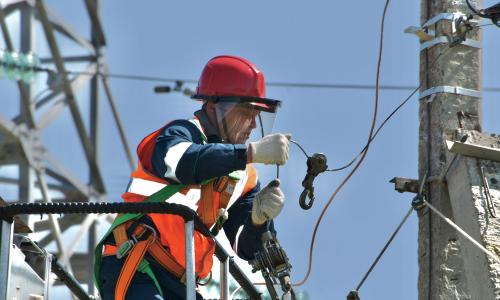Nuclear power plant security warranted considerable attention following the September 11, 2001 attacks. Rather than tout strengths or decry vulnerabilities, this issue brief merely attempts to provide the foundation for a better understanding of the ongoing debates.
Owner Controlled Area, Protected Area, and Vital Area are three key terms in nuclear plant security. The land on which the plant is built as well as many acres of surrounding land is the Owner Controlled Area. Much of the Owner Controlled Area can be accessed without special authorization. For example, many plant sites have Visitor's Centers and boat ramps that are open to the public. In addition, the employee, contractor, and visitor parking lots are typically open-access.
The Protected Area is a relatively small subsection of the Owner Controlled Area. As its name implies, the Protected Area has higher security levels than those provided for the rest of the Owner Controlled Area.
The Protected Area is generally ringed by two parallel fences. The inner fence provides a physical barrier to retard unauthorized access and features intrusion detection equipment that alarms when anyone touches it. Federal regulations mandate that this fence be at least eight feet tall and topped with at least three strands of barbed wire, or equivalent. The outer fence, sometimes referred to as the 'nuisance fence,' serves as a second physical barrier and reduces the number of false intrusion alarms triggered by people, deer, and dogs contacting the fence.
Access to the Protected Area is restricted to authorized individuals only. An authorized individual enters the Protected Area by going to the security building and requesting his or her access badge by its number. A security guard retrieves that access badge and verifies that the person requesting it resembles the photograph on the badge. As a final check, the individual must state his or her last name. With another match, the security guard issues the individual the access badge.
The individual uses the access badge at a card reader to enter the Protected Area. Entry is made through a single-pass gate that looks like an overgrown turnstile because it has horizontal prongs extending from the floor to the ceiling that rotate only far enough to allow one person to enter at a time.
Just as the Protected Area is a subsection of the Owner Controlled Area, a Vital Area is a subsection of the Protected Area. The Vital Area's house equipment that could endanger public health and safety from radiation if destroyed. Vital Areas can also contain radioactive material that could endanger public health and safety if released.
The access cards that authorized individuals carry on their person at all times inside the Protected Area grant them entry into none, one, or multiple Vital Areas. A person's access badge at a card reader will only unlock a door to a Vital Area if that person is authorized to enter. Like in the case of the intrusion detection for the Protected Area fence, alarms will be sounded when unauthorized persons attempt to open the locked doors to Vital Areas. Unlike entry into the Protected Area, individuals do not use single-pass gates to enter Vital Areas. It is left up to Honor Code that workers do not 'tail-gate' behind another individuals to enter Vital Areas without using their access badges properly.
Individuals must use their access badges to leave Vital Areas and the Protected Area. This accountability allows security personnel to maintain a constant tally of how many people are within the security fences and all workers that are currently within Vital Areas.
Recap: Most of the Owner Controlled Area around a nuclear power plant can be accessed by the public without special permission. The double-fenced perimeter surrounding some, but not all, of the buildings at a nuclear plant marks the Protected Area that requires prior authorization and badging to enter. Additional protection is provided by limiting access to Vital Areas within the Protected Area to only those workers specially authorized to enter them.



